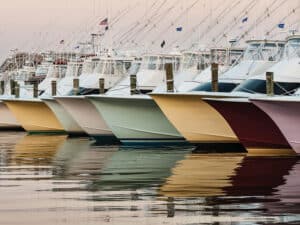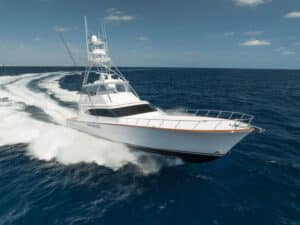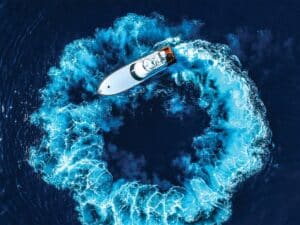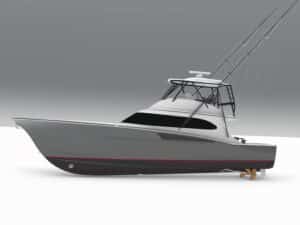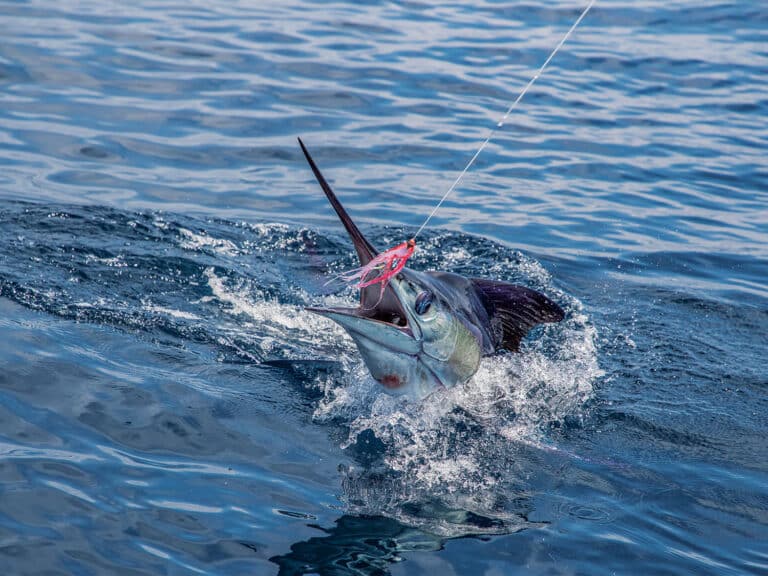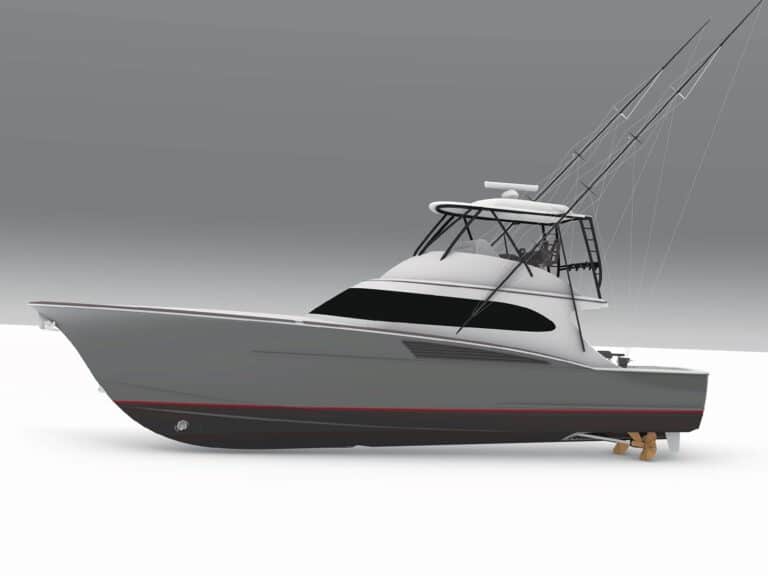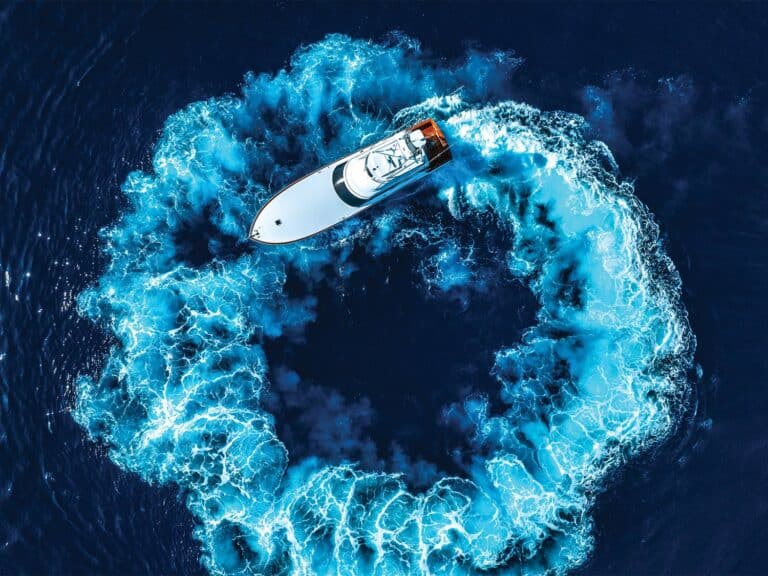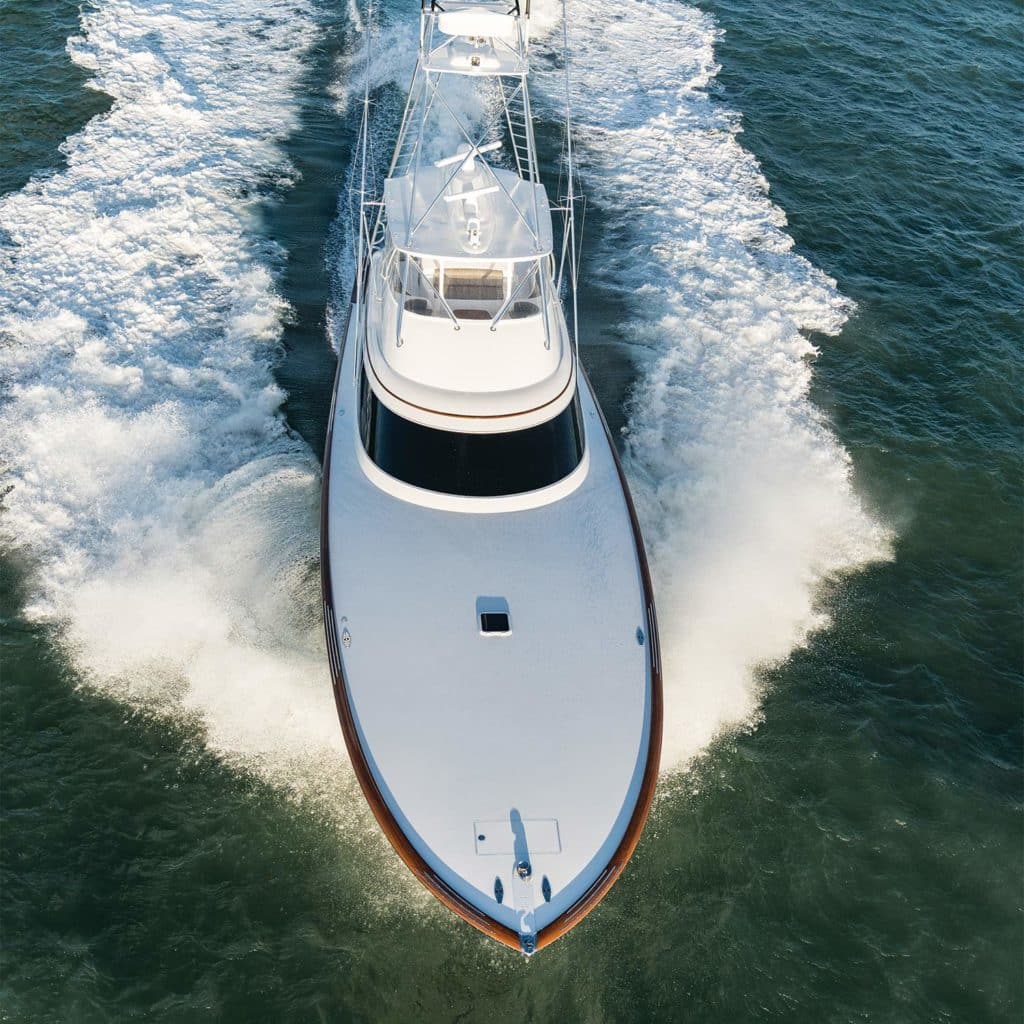
Technology and engineering continue to play a significant role in the advancement of sport-fishing boats. Improvements in those technologies and the many facets of engineering throughout a boat have given us speeds that were unheard of 20 years ago, and it’s not just because we have so much more horsepower. Some of the most obvious benefits are certainly better-riding, better-performing and more-efficient boats of all sizes, thanks to some major developments in hull design as well as the use of modern composite construction materials and their application techniques.
Computer-aided design programs such as Siemens Star CCM+ and the older—but tried-and-true—Autocad for 2D and 3D rendering, Rhinoceros for 3D solid modeling, and Maxsurf and NAPA for bottom design all include tools to measure stability and resistance of the hull bottom. Each of these computer technologies, combined with fluid-dynamics analysis and testing platforms within the software, has given modern hull design a space-age boost of improvement. Basically, a naval architect can predict—and prove—how the boat will run when given a certain weight and horsepower directly on the computer screen, long before the first bit of glass or timber is ever applied to the build.
The Need for Speed
Modern processes such as vacuum bagging and infusion have not only refined and cleaned up the actual build process, but they have also created a better overall product while assisting in saving weight. Materials such as hybrid epoxies, high-modulus fabrics, and carbon-fiber and composite cores have not only made boats lighter, but much stronger and tougher as well. Having the ability to engineer and blend these various materials in different areas of the boat where they will benefit the most is a huge push to having better boats. While most of these things have the goal of adding strength, they also save weight, which brings us to the benefit that’s been chased the most over the past 30 years: speed.
When the first production sport-fishing boats hit 30 knots in the late 1970s, it was a big deal. Prior to this milestone, there were some custom builders such as Jim Smith with his racing background who built fast boats capable of 30 knots and more, but production boats had not yet reached that level of performance. Amazingly, the 30- to 40-knot range is where we mostly are today, even though the average sportboat lengths have swollen from 30 to 45 feet to a more common 65 to 80 feet. The speed is there thanks to increases in high-horsepower diesel engines. These days, builders and engine manufacturers scratch and claw to get another knot here or there.
With the engineering and analytics also looking at everything to gain speed and a better boat ride, the focus has now shifted to include hull appendages. What is creating drag or resistance in the water that is slowing us down? The answer: anything that is attached to the bottom. Through-hulls, transducers, mounts and, clearly, the big three—struts, propellers and rudders—have become targets to study and find ways to reduce their ill effects on hull efficiency and speed, as well as the byproducts of vibration and noise. Some interesting technology is creeping into the sport-fishing world of boatbuilding: wake-adapted struts, rudders and propellers.
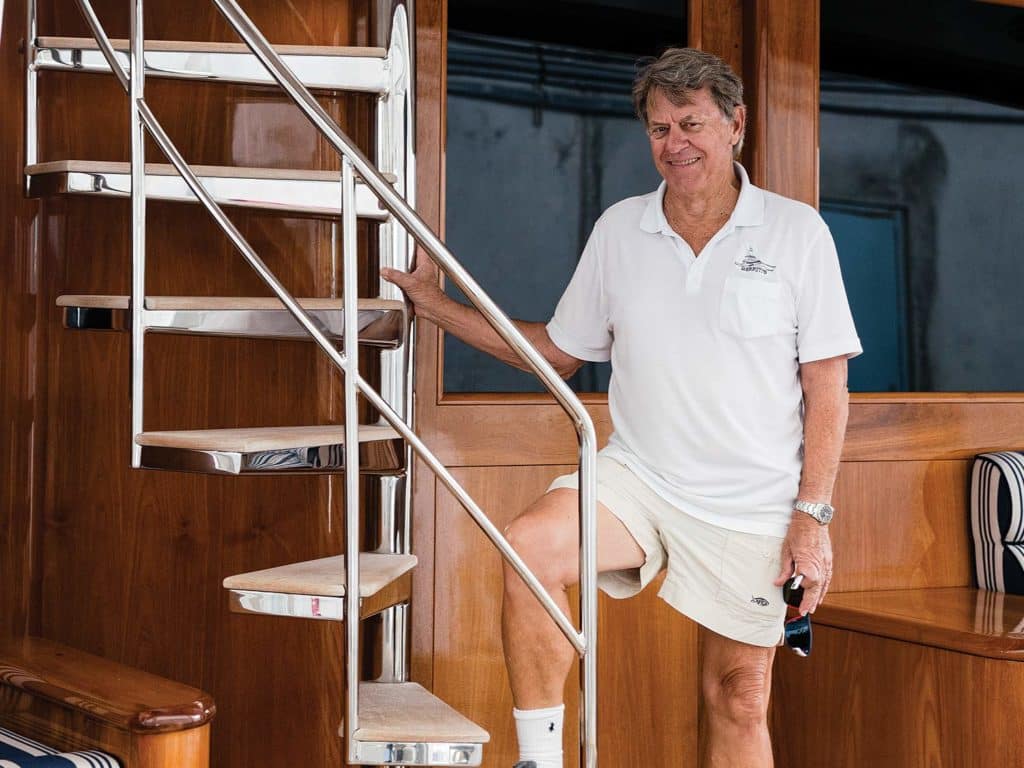
Coming of Age
This information and technology has been around for more than 100 years in military and commercial applications, but the first time I heard about this as applied to sport-fishing boats was when builders Jarrett Bay and Mark Willis applied these new running-gear designs to their custom builds around 2015 and 2016. They saw immediate results in all areas.
I happened to be sitting in Roy Merritt’s office in January 2019 when he was looking into it. Through Willis’ past experience and recommendations, Merritt had contacted the fellow who had helped him. According to his online bio, Dr. Brant Savander has been a consulting naval architect for nearly 30 years, and has been actively involved in the research, design, and analysis of propulsion systems that include cavitating, ventilating, and surface-piercing propellers. I knew that Merritt was on to something interesting with this discussion.
Most recently, after the launch and testing of the first 77-foot Merritt with this new gear, we reviewed the data and spoke about the process. “We’re very conservative about how we do things,” Merritt says. “Over the years, we’ve had a lot of newfangled things brought to our attention, and most of them are gimmicks. So when we heard about these wake-adapted struts and rudders, of course, I wouldn’t believe the claims at first. Then I spoke to my boatbuilding friend Mark Willis about them and the tests he did. Some tests you can’t even believe, but I can believe Mark because he is a good, honest boatbuilder. So we looked at it and decided to go with it for our new boats. It’s very expensive when you start out, but when you look at the benefits, it outweighs any expense you can come up with. Mark told me that if you did nothing but consider the smoothness gained for the boat, it’s worth every penny, let alone the speed benefits as well. And that’s exactly what we found out. We gained a good 2 to 2-and-a-half knots on our 77, and we almost eliminated the station-wagon effect misting the cockpit.”
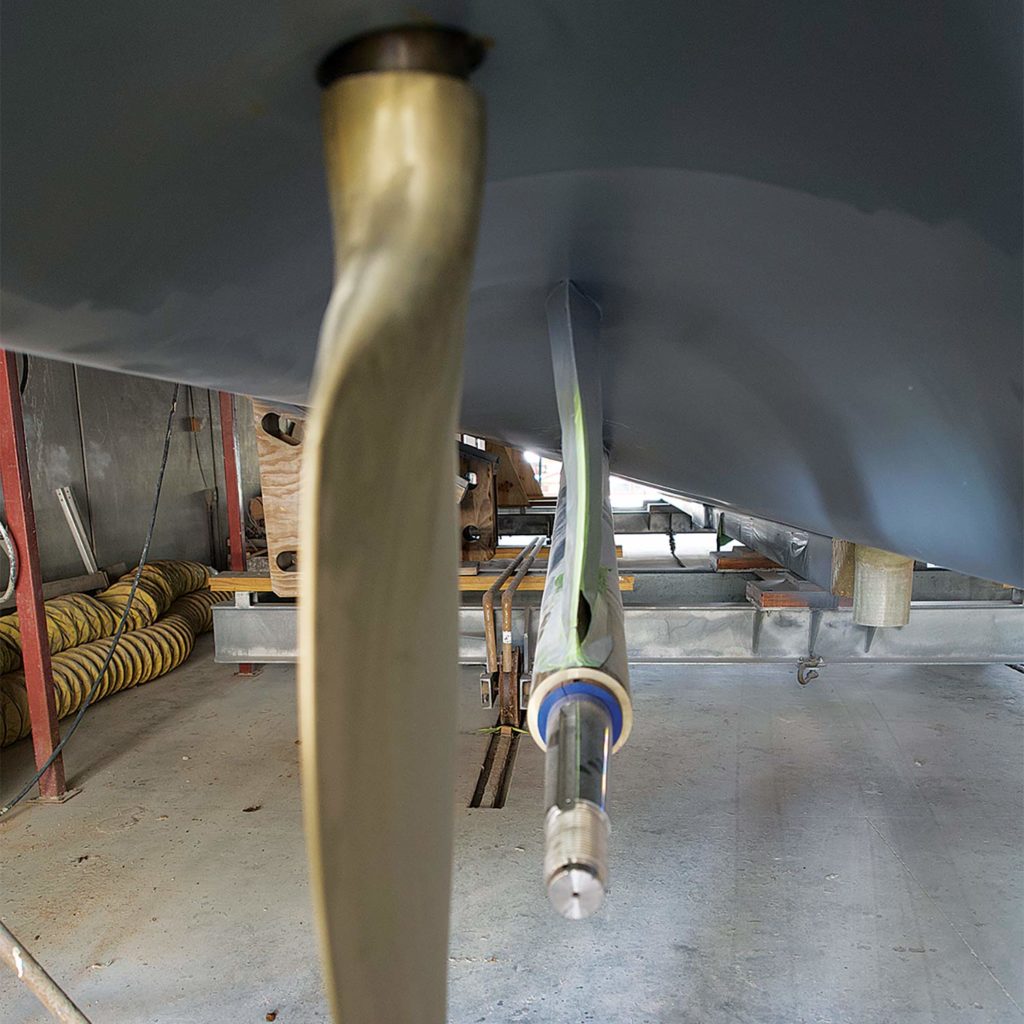
He continues: “What this means is that the water is not being chopped up by the wheels, but instead, that water is coming into the wheels much cleaner from the struts. Something else we noticed on the first boat we did is that all these overpitched wheels have a little bit of burning at the hub of the wheel, but we don’t see any burning either. So again, it tells you a bit about what the struts are doing. I wouldn’t do it any other way. It just works.”
When we hear the term “wake,” most assume that it is the trailing waves or wakes that come off the boat’s sides as it moves through the water. In this instance, wake refers to the water that is disturbed under the boat as well. As the boat moves forward and water flows past the hull, that water is channeled—or directed—in many different ways. Back in the late 1980s, Peter B. Wright and I were producing a video and shooting some various scenes in the Bahamas. I laid on the bottom in 15 feet of water on the white sand off Bimini with an underwater video camera and had Wright drag baits with different leaders over me to see what differences there were in various materials and sizes of wire, mono, and fluorocarbon. We studied the swimming baits, hook sizes, and also different lure shapes and hook-sets.
I was also getting some great video of the boat going over me and watching the water move around the hull, as well as the wake it produced and how much air was introduced to the bubble trail behind it. Once we were through experimenting with the tackle, I asked him to run the boat over me at cruise and then wide open. Later that evening, we watched the replay, and lo and behold, the builder was quite surprised and amazed to see how much water was really being disturbed by the boat’s hull strakes and running gear, especially the struts. In slow motion, we could clearly see air being introduced from the strakes and struts into the props. On subsequent boats, the strakes were reduced in length and altered relative to the keel and chine in an attempt to clean up the flow of water to the props.
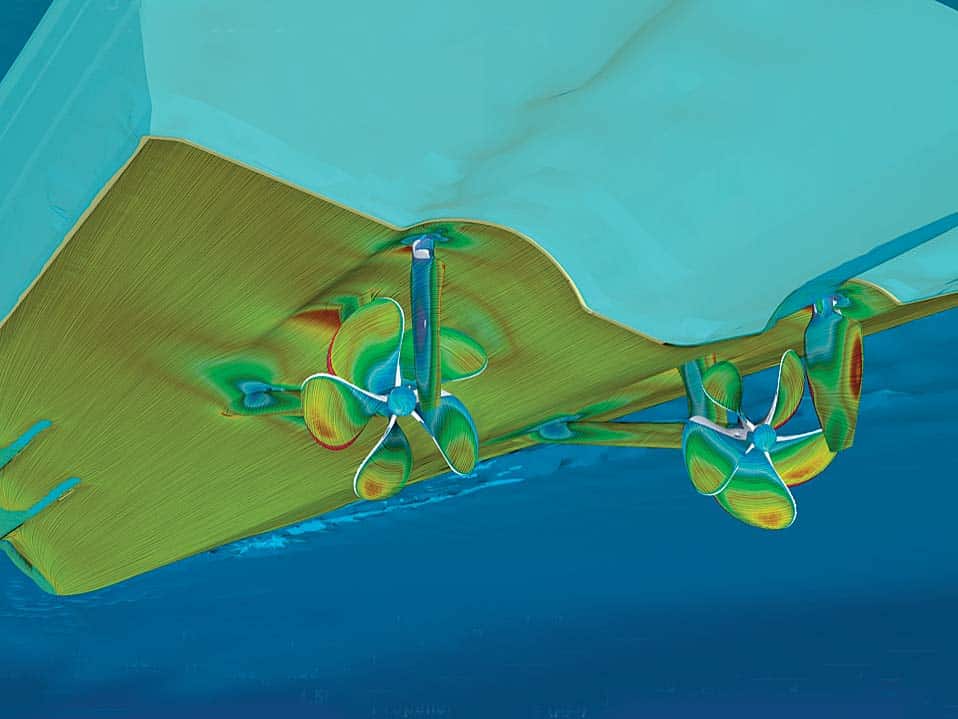
When looking at the bottom of a boat, there are plenty of things that can create drag. Drag is resistance, which must be overcome by thrust in order to advance the boat. Drag is caused by appendages such as the struts, rudders and props, but also by running strakes, through-hull flanges and screens, transducers, and even sometimes the hull design itself. Now we add higher horsepower for increased speed, and the effects of all these things are accentuated further. These factors attack the boat as noise and vibration.
The Big Three
This is where wake-adapted propellers, struts and rudders really shine, and thanks to some great technology and brilliant minds, this technology is becoming more available. Today, companies such as Michigan Wheel, as well as Dr. Savander with his Maritime Research Associates, are utilizing advancements in computational fluid dynamics, which are computer simulations to see how water flows off or around a surface. The computer programs allow them to make minute adjustments to compensate for fuel burn-off, shaft angle, and obviously varying speeds. They can also make changes to the hull design itself to see what the effects are and how they relate to the running gear.
Starting with the strut: If it can be shaped to adapt to the flow coming from the hull bottom, it will help increase efficiency. By shaping the appendages to accept the water with less disturbance, it reduces some of the ill effects of drag and noise. Second is the propeller: We’ve all seen the effects of cavitation burns on the hub and inner sections of the props. By shaping the propeller in a way to accept the water more cleanly, and allowing the water to flow off without creating a vortex of air to burn the surface, thrust is increased and less vibration is taking place. Another significant benefit is a reduction in burning and pitting of the hub and blade surfaces of the propeller.
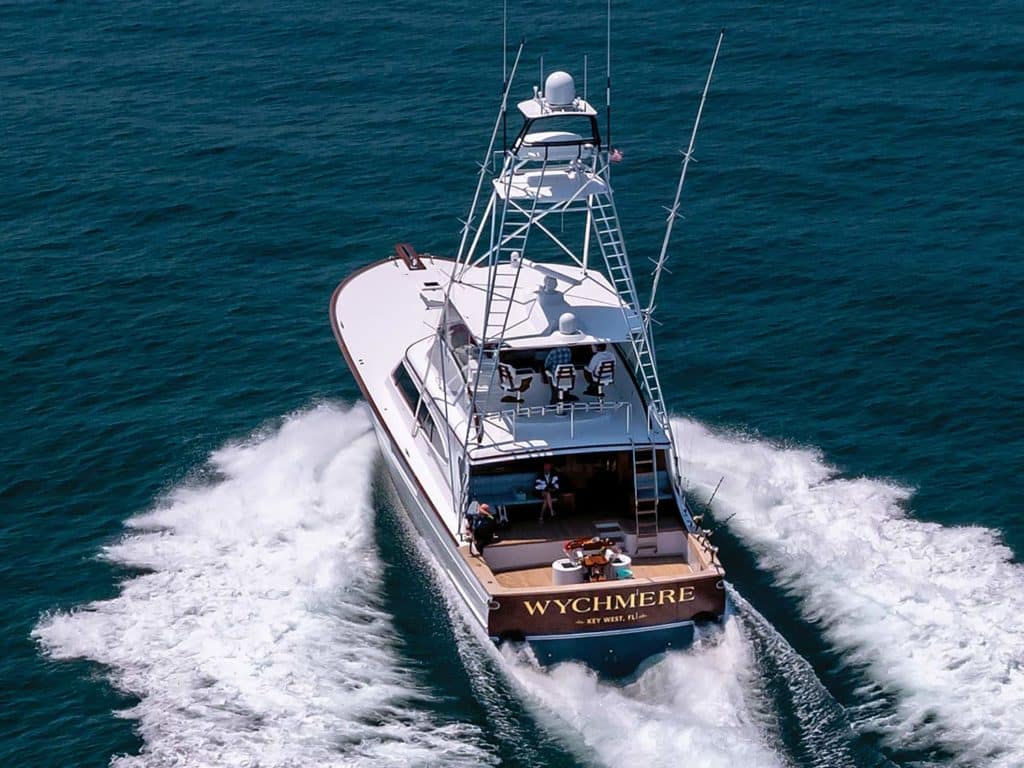
The third is a big one: the rudder. Shaping the rudder to accept the water as it flows off the strut and through the propeller with as little disruption as possible creates less vibration and noise. Using computational fluid dynamics, it is possible to shape a rudder that adapts to the water flow, reduces drag, and even converts that energy to thrust. And more thrust equals more speed, with less noise and vibration.
Read Next: Learn more about the Costa Offshore World Championship, including how to qualify to participate.
Looking to the Future
Technology has done so much for boating and fishing, and this is yet another example of analytics proving the benefits of science. Addressing the small details improves the bigger product. In this case, the inclusion of wake-adapted propellers, struts and rudders offers things every boat should have in terms of improved hull efficiency, reduced vibration, less noise, and as a result, even greater speed.
